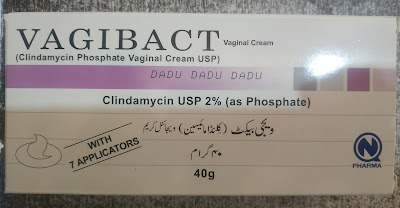Vaginal Cream (Clindamycin Phosphate Vaginal Cream USP)
COMPOSITION Vajibect Cream
Each gram cream contains:
Clindamycin (as Phosphate) USP
20mg. [USP Specs.
MICROBIOLOGY & CLINICAL PHARMACOLOGY of Vajibect Cream
Clindamycin inhibits bacterial protein synthesis at the level of the bacterial ribosome. The antibiotic binds preferentially to the 50s ribosomal subunit and affects the process of peptide chain initiation. Although Clindamycin p phate is inactive in vitro, rapid in vivo hydrolysis converts this compound to the antibacterially active clindamycin. Clindamycin has been shown to be active in vitro against the following organisms which have been associated with bacterial vaginosis. Gardnerella vaginalis, Mobiluncus spp., Bacteroides spp. Mycoplasma hominis, Peptostreptococcus spp., Approximately 4% (range 0.8-8%) of the administered dose of Clindamycin (100mg in 5g of cream, is absorbed after vaginal administration.
PHARMACOKINETIC PROPERTIES Vajibect Cream
Following a once a day intravaginal dose of 100mg of Clindamycin Phosphate vaginal cream 2%, administered for 7 consecutive days to 5 women with bacterial vaginosis, absorption was slower and less variable than that observed in healthy females. Approximately 4% (range 2% to 8%) of the dose was absorbed systemically. These peak concentrations were attained approximately 14 hours post-dosing trange 6 4-24 hours). There was little or no systemic accumulation of Clindamycin after repeated (7 day) vaginal dosing of Clindamycin phosphate vaginal cream 2%. The systemic half-life was 1.5 to 2.6 hours.
INDICATIONS of Vajibect Cream
Antibiotic for the treatment of bacterial vaginosis.
DOSAGE AND ADMINISTRATION Vajibect Cream
One applicatorful (Approximately 5g of cream) intravaginally at bedtime for 7 consecutive nights or as directed by the doctor.
OVERDOSE of Vajibect Cream
Vaginally applied Clindamycin phosphate vaginal cream 2% can be absorbed in sufficient amounts to produce systemic effects. In the event of overdosage, general symptomatic and supportive measures are indicated as required.
CONTRA-INDICATIONS of Vajibect Cream
VAGIBACT Cream is contra-indicated in patients previously found to be hypersensitive to preparations containing Clindamycin or any of the components of the cream base. It should not be used in patients having Lincomycin sensitivity, inflamatory bowel disease, or antibiotic associated colitis.
When not to use Vajibect Cream
As there are no data available on the use of VAGIBACT Cream in patients younger than 12 years of age, it should not used in this population.
PREGNANCY AND LACTATION Vajibect Cream
Reproduction studies have been performed in rats and mice using subcutaneous and oral doses of Clindamycin ranging from 20 to 600mg/kg/day and have revealed no evidence of impaired fertility or harm to the fetus due to Clindamycin. There are no adequate and well controlled studies in pregnant women during their first trimester, and because animal reproduction studies are not always predictive of human trimester, VAGIBACT Cream was effective in treating bacterial vaginosis, and no drug related medical events were reported in the neonates. However response, this drug should be used during the first trimester of pregnancy only if clearly needed. In a clinical trial in pregnant women during the second
as with any drug used during pregnancy, a careful risk benefit assessment should be considered before hand. It is not known if Clindamycin is excreted in breast milk following the use of vaginally administered Clindamycin phosphate.
INCOMPATIBILITIES Vajibect Cream
None known.
CONDOMS & DIAPHRAGMS of Vajibect Cream
Not to be used during treatment with VAGIBACT Cream.
UNDESIRABLE EFFECTS of Vajibect Cream
The following treatment-related adverse events were reported: Cervicitis/vaginitis: vulvo-vaginal irritation, dizziness, headache, vertigo, heartburn, nausea, vomiting, diarrhoea, constipation, abdominal pain, rash, exanthema, urticaria.
How to USE Vajibect Cream
Plastic applicator provided in pack is designed to allow proper vaginal administration of VAGIBACT Cream. Remove cap from cream tube. Then pierce the seal of the tube by means of the pin on the top of the cap. Screw a plastic applicator on the threaded end of the tube. Rolling from the bottom, squeeze gently and force the medication into the applicator. The applicator is filled when the plunger reaches its predetermined stopping point.







0 Post a Comment: